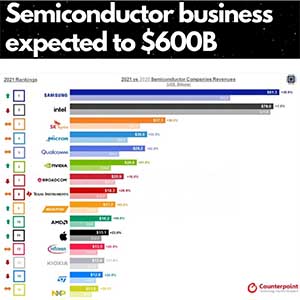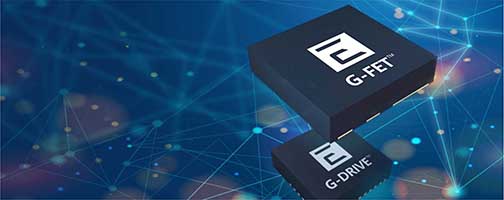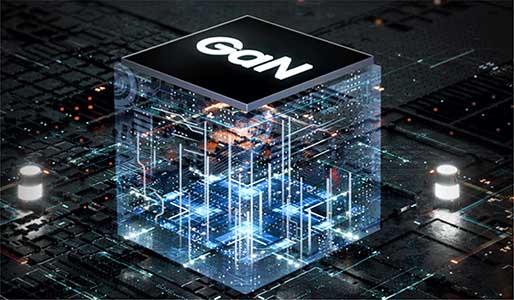Power semiconductor devices with Gallium Nitride (GaN) and silicon carbide (SiC) are gradually replacing their silicon-based coAunterparts, largely because using GaN or SiC power transistors can lead to more straightforward and efficient energy storage solutions. The combined GaN and SiC market is projected to be valued at over US$3 billion by 2025 and will be substantially driven by renewable and electric vehicles.
Key Highlights
- At a CAGR of 24.95% from 2022 to 2030, the market for Gallium Nitride is expected to grow from its estimated value of USD 0.32 billion in 2021 to USD 2.44 billion by 2030.
- The market for Gallium Nitride is divided into segments based on the product, component, wafer size, geography, end-users, and rivals.
- Fast mobile chargers and commercial applications propel the Gallium Nitride market worldwide.
- The worldwide Gallium Nitride Market will benefit from future prospects in the defense sector.
- Globally, the Asia Pacific region has the largest market share for Gallium Nitride. North America and Europe both follow this tendency.
GaN is a crystal-like semiconductor with remarkable features. GaN has been used in electronics for decades, first in LEDs to light TVs and computer screens and subsequently in solar panels to turn light into power. GaN is overtaking silicon as the industry’s preferred semiconductor material.
In the last year, several USB charger manufacturers have spoken about GaN or Gallium Nitride. A Gallium Nitride power IC combines GaN power (FET), drive, control, and protection in a single SMT package. These GaN Fast TM power ICs are high-performance, digital-in, power-out building blocks. The gate drive loop’s near-zero impedance permits nearly negligible turn-off loss. Turn-on performance may be modified for individual applications.
“Ease-of-use” implies speedier prototyping and maximum “first-time-right” concepts for designers, while strong, high-quality performance means low qualification time. Time-to-market and time-to-revenue are accelerated.
Tier-1 OEMs, including Dell, Lenovo, Samsung, Xiaomi, LG, and OPPO, plus aftermarket vendors like Belkin, Anker, AUKEY, Hyper, and Baseus, have produced GaN fast chargers.
Gallium Nitride (GaN) is gaining popularity because it improves performance in various applications while using less energy and space than silicon. Gallium nitride technologies are becoming critical in certain applications where silicon as a power conversion platform has reached its physical limitations. In others, the advantages of efficiency, switching speed, compactness, and high-temperature operation make GaN more desirable.

GaN technology will assist fulfill global energy needs while reducing carbon emissions. GaN design and integration offer next-generation power semiconductors with a ten-times reduced carbon footprint than older, slower silicon chips. An upgrade from Si to GaN would minimize energy loss by 30-40%, saving about 100 TWhr and 125 Mtons of CO2 by 2030.
Gallium Nitride’s advantages go beyond operational performance and system efficiency. GaN offers a strong ‘green’ edge over older, slower silicon since it saves 80% in manufacturing, process chemicals, and energy and more than 50% in packaging.
Gallium Nitride is used in hybrid and electric automobiles for power conversion and battery charging. GaN-based power products are used in solar inverters, motor drives, and other industrial applications.
Compared to silicon, which has a band gap of 1.12 eV (electron-volts), GaN and SiC have band gaps almost three times greater at 3.39 eV and 3.26 eV, respectively. This implies that both can handle larger voltages and frequencies, albeit a few distinctions affect how they operate and where they are utilized.
The speed of electron mobility – how rapidly electrons may flow through the semiconductor material – is one distinction between GaN and SiC. GaN’s electron mobility is 30% faster than silicon, at 2,000 cm2/Vs., whereas SiC’s electron mobility is 650 cm2/Vs. These distinctions influence the advantages that each technology provides to a given application.

GaN’s increased electron mobility, for example, makes it considerably more appropriate for high-performance, high-frequency applications, which is further helped by the gate electrode using a very, very little fraction of the chip. This results in extremely low capacitance, making it possible to obtain higher frequencies (which is why GaN semiconductors are widely used in RF devices that switch in the gigahertz range).
SiC, with its higher thermal conductivity and lower-frequency operation, is better suited for higher-power applications, such as EVs, data centers, solar-power designs, rail traction, wind turbines, grid distribution, and industrial and medical imaging, which do not always require high-frequency switching but do need a higher-voltage operation and improved heat dissipation.
GaN and SiC are superior to silicon for power processing and quick charging. 650V GaN is suited for 20kW applications with quicker switching, integration, and reduced costs. SiC’s high voltage and temperature qualities make it ideal for 1,000V and 20MW devices.
Consumer demand for high-performance, low-cost power conversion equipment is driven by greater battery life, quicker phone charging, EVs, and power tools. Consumers expect quicker data connection and sophisticated AI offered at reduced cost through a huge network of hyper-scale datacenters, telecom server farms, and forthcoming 5G communication towers.
Advanced power electronics handle electric utility voltage via numerous stages to power our products efficiently and cost-effectively. The continuous invention has resulted in generations of high and low-voltage silicon power transistors that keep improving generation after generation.
Power semiconductors have traditionally utilized silicon substrates but can’t handle high voltages. Silicon is being replaced with gallium nitride (GaN). Innovative GaN technology delivers greater switching frequencies and fewer losses. Semiconductor makers’ advances in GaN technology promise longer battery life, quicker charging, and faster data transfer for mobile phones, EVs, and power tools.
GaN transistors are more efficient and quicker than traditional silicon devices. But if these technologies are excellent, what prevents their widespread adoption?
Performance
• Low on-resistance (RDS(ON)) due to high electron mobility of the two-dimensional electron gas (2DEG)
• High breakdown voltage linked to large band gap (3.4 eV) and high critical electric field
• Low capacitances
• Low gate charge
Benefits
• Lower on-resistance than conventional silicon devices with higher operation frequency capability
• GaN bidirectional switching diodes can be advantageous in certain circuit topologies such as OBC
• CMOS-compatible lateral device suitable for monolithic integration of control circuitry
Gallium Nitride Market Size is projected to reach USD 3 billion by 2030, growing at a CAGR of 24.95%: Straits Research
The worldwide gallium nitride market was valued at USD 0.32 billion in 2021 and is expected to reach USD 3 billion by 2030, growing at a 24.95% CAGR between 2022 and 2030. The Asia Pacific region dominates the Gallium Nitride market.

Opportunities Lie In the Defence Sector:
The increasing usage of technologically superior Gallium Nitride systems in the defense and aerospace sectors will likely drive market growth. The rising need for improved bandwidth and performance dependability in radio communications, radars, and other applications is driving the growth. SiC is a good material for fabricating bullet-resistant jackets due to its endurance and tensile strength. Radars use GaN-based integrated circuits for effective navigation and real-time air traffic management. In addition, GaN can provide greater operating frequencies for military jammers, terrestrial radios, and radar communication. Several worldwide defense forces are expected to boost their usage of wideband Gallium Nitride power transistors, contributing to economic growth.
The worldwide gallium nitride semiconductor devices market is predicted to develop at a compound annual growth rate (CAGR) of 12.13%, from $6.24 billion in 2021 to $7.00 billion in 2022. The reversal in growth tendency is mostly due to businesses re-calibrating their production after responding to demand that increased dramatically during the COVID-19 epidemic. The market is estimated to reach $12.41 billion by 2026, growing at a 15.38% CAGR.
The Gallium Nitride semiconductor devices market comprises sales of semiconductor device goods by entities (organizations, single traders, and partnerships) that manufacture semiconductor devices such as transistors and diodes for converting energy to power using gallium nitride material. The dynamic electric and chemical features of Gallium Nitride semiconductor devices are employed to create electrical power devices that are very hard, mechanically stable, high voltage, and have a high frequency.
Gallium Nitride semiconductors are replacing silicon-based semiconductors because they can fulfill rising demands for enhanced power system efficiency, performance, and affordability.
This study segments the components of the market for gallium nitride semiconductor devices: transistor, diode; rectifier; and power IC. They are related to Opto-semiconductors, power semiconductors, and RF semiconductors, among others. These semiconductors are used in various applications, including lighting and lasers, power supply and inverters, radio frequency, power drives, consumer and business, industrial, telecommunications, automotive, renewable energy, aerospace and military, and healthcare. These semiconductors have wafer sizes of 2 inches, 4 inches, 6 inches, and 8 inches.
In 2021, North America dominated the market for gallium nitride semiconductor devices. Asia-Pacific is anticipated to be the fastest-growing area throughout the foreseeable future. The market for gallium nitride semiconductor devices is anticipated to expand due to the rising demand for consumer electronics.

Gallium Nitride is one thousand times more mobile than silicon.
Since it is less costly to manufacture than conventional semiconductors, it is more prevalent in consumer electronics. According to the Consumer Electronics and Appliances Manufacturers Association (CEAMA), the Indian appliances and consumer electronics industry is predicted to reach $26.81 billion during the next five to six years, a growth rate of more than double. In addition, Clear Sale predicts that the consumer electronics market will generate more than $360 billion in sales in 2020 and more than $450 billion by 2024. Consequently, the rising demand for consumer electronics is propelling the market for gallium nitride semiconductor devices.
Technological progress is a significant trend gaining traction in the Gallium Nitride semiconductor devices market. The market’s leading players are concentrating on creating new technical solutions to improve the dependability of power supply circuits.
For example, ROHM Semiconductor, a Japan-based electronic device company that specializes in the design and manufacture of semiconductors, integrated circuits (ICs), and other electronic parts, developed the industry’s highest (8 volts) gate breakdown voltage technology for 150V Gallium Nitride HEMT devices for power supply circuits used in various industries and communication equipment in May 2020. This improves the design margin and the dependability of power supply circuits utilizing GaN devices that demand high efficiency.
Exagan was bought for an unknown sum by STMicroelectronics, a Swiss semiconductor device developer, in March 2020.
The purchase is intended to boost STMicroelectronics’ long-term business of gallium nitride semiconductor devices and its goal of delivering power semiconductors.
Exagan is a French-based manufacturer of Gallium Nitride semiconductor devices.
Asia-Pacific, Western Europe, Eastern Europe, North America, South America, the Middle East, and Africa are the areas covered in this research. The Gallium Nitride Semiconductor Devices market research includes data for the following nations: Australia, Brazil, China, France, Germany, India, Indonesia, Japan, Russia, South Korea, the UK, and the United States.
Major players in the gallium nitride semiconductor devices market are Cree, Inc., Efficient Power Conversion Corporation, Fujitsu Ltd., GaN Systems, Infineon Technologies AG, Qorvo, Inc., Nexgen Power Systems, NXP Semiconductor, Texas Instruments Incorporated, Toshiba Corporation, Samsung, Mitsubishi Electric, MACOM, ST Micro Electronics, Panasonic, Dialog Semiconductor, ST Micro Electronics, Panasonic, and Dialog Semiconductor.
Recently, the renowned Gallium Nitride Ecosystem Enabling Centre and Incubator (GEECI) at the Indian Institute of Sciences (IISc), Bengaluru, was visited by the Union Minister of State for Electronics & Information Technology.

Gallium Nitride Technology in India-
Using straightforward design procedures, Indian researchers created a high-performance industry-standard model for Aluminum Gallium Nitride (AlGaN/GaN) High Electron Mobility Transistors (HEMTs) in December 2021. Because of its high breakdown voltage, this model can be used to create high-power Radio Frequency (RF) circuits.
- Amplifiers and switches used in radio frequency circuits are helpful for space and military applications and wireless communication.
- The standard created can significantly lower the development cost of the circuits and devices for high-frequency signal transmission because AlGaN/GaN HEMTs can also increase the power level of solid-state microwave circuits by five to ten. This results in a noticeable reduction in overall chip size and cost.
- It has two excellent properties – high mobility and high-power performance.
- When Low Noise Amplifiers (LNAs), which are used in wireless transmissions like mobile phones and base stations, are designed, these characteristics lower the noise figure and complexity while raising the possible bandwidth.
- For high-frequency and high-power applications like 5G, radars, base stations, satellite communications, etc., AlGaN/GaN HEMTs have emerged as the preferred technology.
- In this work, the team at IIT Kanpur, led by Prof. Yogesh Singh Chauhan, created and standardized the Advanced Spice Model for GaN-HEMTs, a physics-based compact model for AlGaN/GaN HEMTs (ASM-HEMT).
Gallium Nitride applications are implemented in various technologies, including wireless charging, server SMPS, and telecom/datacom. Gallium nitride electronics established new benchmarks for high quality, energy efficiency, and usability because of their very efficient and compact design. Many businesses provide reliable and effective solutions for GaN-on-Si power technology devices and applications by producing GaN power transistors on Si substrates for switching applications.
The Future Ahead…!
There are still numerous process barriers to overcome before this is feasible, but it may be feasible in the next few years to have a CMOS-compatible GaN process. This would allow high-frequency and high-power GaN devices to be integrated with high-density storage and digital logic circuits. As a result, whole high-power and high-frequency communication system-on-chips (SoCs) may be created, with RF transceivers, field programmable gate arrays (FPGAs), CPUs, and data storage integrated. Because GaN transistors cannot be manufactured at the same scale as silicon transistors, they are now unfeasible for use in CPUs and other microcontrollers.
GaN provides numerous significant benefits over silicon, including greater power efficiency, quicker processing, and even better recovery. However, although GaN seems a better alternative, it will not replace silicon in all applications for some time.
The first barrier to overcome is the depletion nature of GaN transistors; efficient power and logic circuits need both normally-on and normally-off transistors. While normally-off GaN transistors are possible, they either depend on a standard silicon MOSFET or need unique extra layers that make shrinking difficult.
More research is being carried out to make GaN more efficient and accessible. Panasonic, for example, has patented an AlGaN layer technique for manufacturing an improved GaN transistor. This implies that unless other firms perform their research, every breakthrough involving that particular transistor type will depend on Panasonic. Meanwhile, those other businesses are working on their means of producing upgraded GaN transistors. The results of these initiatives will influence GaN’s future viability in the market.
Although research on GaN devices has been ongoing since the early 2000s, GaN transistors are still in their infancy. While there is little question that they will eventually replace silicon transistors in power applications, they are still a long way from being employed in data processing applications.
However, if GaN devices can be downsized (with features smaller than 100nm), they can not only be utilized to replace silicon for improved power efficiency, but they can also function at much higher speeds, allowing CPU power to continue to rise.
Conclusion
Opportunities exist for developing several technologies and materials; among them, the semiconductor technology using wide band gap, semiconductors are crucial. The market for gallium nitride semiconductor devices is seeing significant growth, and one prominent trend is the introduction of new technologies. Market leaders are investing heavily in research and development of novel technical solutions to improve the stability of power supply circuits. For better power system efficiency, performance, and system cost, gallium nitride semiconductors are becoming more popular as an alternative to silicon-based semiconductors.
Gallium nitride has greater efficiency, thermal stability, and capability for use in power devices requiring more load or higher frequencies at higher temperatures. The widespread use of gallium nitride, a semiconductor material with a bright future, will increase the availability of tiny, high-frequency devices. Check out some power electronics like GaN MOSFETs.












